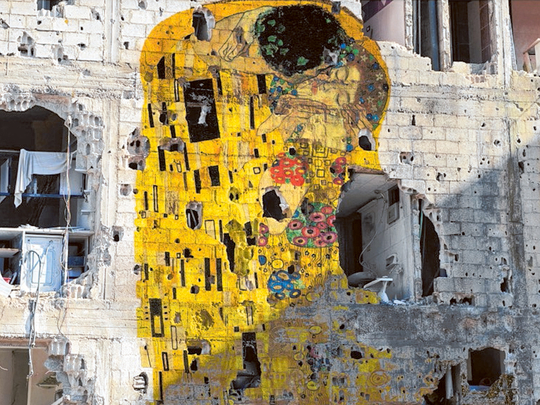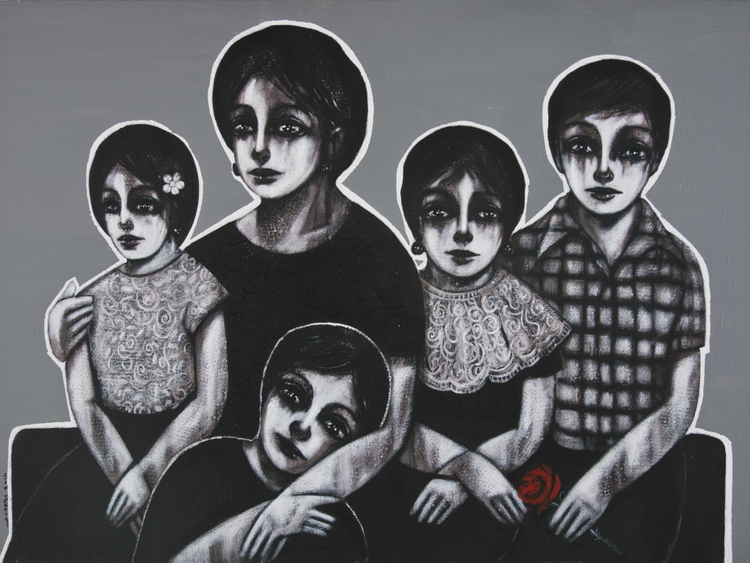
Syrian artist Mohannad Orabi is interested in exploring the psychology of memory, and how it shapes one’s perception of formative experiences. Early in his career, he became well-known for his paintings of vivacious childlike figures in various scenarios. The paintings — all titled “self portrait” — revealed his fascination with the evolution of consciousness in childhood and the wonder and whimsy of the formative years that first shape our comprehension of the world.
But after the conflict in his country forced him to move to Cairo, and then to Dubai, his naïve figures became more realistic and grown up, and their eyes opened as they witnessed the turmoil and tragedy in the region.
Displaced from his home and separated from family and friends, Orabi relied on the media to get news about his country and on social media to communicate with his loved ones. So he took inspiration from media images, martyr posters and profile pictures on social media to paint portraits of Syrians under siege, displaced and in exile, as a way of documenting the human side of the conflict.
In his latest exhibition, “Family Portrait”, the artist continues to investigate ways in which visual culture, social media and digital communication have replaced what was once tangible. The show features a series of large paintings that evoke the feeling of old black-and-white formal family portraits taken in a studio. The paintings depict families huddled together, often showing the mother with her arms protectively placed around her children, or with a child resting his head on her lap.
In some paintings a child is seen holding a teddy bear. The paintings are a nostalgic look at the past, and a sad reminder of the present, when families have been torn apart by conflict.
“I have always loved the idea of a family dressing up, going to the studio and posing together, with everyone looking at the camera. But after moving from country to country I see these photographs in a different way. I imagine that these families have been displaced and separated. Rather than seeing each other they see profile pictures and images of each other on social media. While doing these paintings I worked spontaneously and the figures just emerged from my memory and imagination to create these family portraits,” Orabi says.
An interesting feature in the paintings is a thin white border that outlines the contours of the figures binding them together and delineating them from the background. “This line is like a shield around the family that keeps them together and separates them from the grey background, which represents the grim situation around them,” the artist says.
The paintings are largely black, white and grey, but there are splashes of red in the form of roses in the hands of some of the figures. In one painting, a little girl is seen holding two huge bouquets of red roses, with some flowers strewn on the ground around her.
“Red means different things at different times. It could be a symbol of pain, danger, violence or love. But whatever your situation, getting a red rose from somebody is enough to change your mood for the better. These roses in my paintings offer hope and positivity for a better future,” Orabi says.
Although the eyes of the people in the paintings are filled with sadness, there is a hint of a smile on their lips. “I did not plan to create these expressions — they just happened. This reflects my own reality. Although I have sad memories, I have to try and smile through it and believe in the future and never lose hope. Like that little girl grabbing the roses in her arms I am still fighting to be happy, to take care of my family and trying not to worry about the future and to live the kind of life that is depicted in the old portraits,” he says.
The artist’s longing for home is expressed through intricate patterns on the clothes of his figures that are inspired by traditional Syrian fabrics. But he has also used sand from the Dubai desert on his canvases to bring in his new environment.
“In Dubai I have learnt how to think globally. I have met people of so many different nationalities here and seeing how they interpret my paintings in the context of their backgrounds has helped me to discover new things about my work,” Orabi says.
“As an artist my aim is to reflect my reality and psychological atmosphere at the moment with the utmost honesty and simplicity. The people in my paintings are not just faces and figures for me. They become my close friends. I live with them, talk to them and have coffee with them. Each of them reflects my soul in some way, and each of these families reminds me of my family in different ways. This is my way of telling the story of Syria to the world. But I hope every viewer can connect with these paintings and put themselves in the picture and make up their own stories with these characters,” he adds.
Jyoti Kalsi is an arts enthusiast based in Dubai. The show will run at Ayyam Gallery, DIFC until October 30














